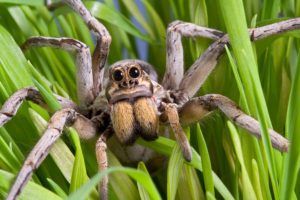 The common name reflects that these are hunting spiders and will chase their prey; the family name and typical genus Lycosa are from the Greek word foi wolf. These spiders are often big and hairy which alarms some people, but they are primarily nuisance pests. Over 100 species occur in the United States and Canada. This section will be restricted to members of the genus Lycosa which contain, me large and hairy species of wolf spiders.
The common name reflects that these are hunting spiders and will chase their prey; the family name and typical genus Lycosa are from the Greek word foi wolf. These spiders are often big and hairy which alarms some people, but they are primarily nuisance pests. Over 100 species occur in the United States and Canada. This section will be restricted to members of the genus Lycosa which contain, me large and hairy species of wolf spiders.
Adult female body length 3/8-1 3/8″ (9-35 mm), male body length 1/4-3/4″ (6-20 mm); cephalothorax and abdomen very hairy. Color usually Can-, crown, often with paler stripes or markings, or sometimes yellow with dark stripes markings. With 8 dark eyes, front row of 4 small, evenly spaced, eyes slightly cure towards rear medially, posterior row strongly curved forward medially forming 2 rows, center/front 2 eyes very large and lateral/posterior 2 eyes of intermediate size; appear as 3 rows of 4, 2 and 2.
The egg sac is spherical, consisting of an upper and lower half united at the middle. It is carried on the female’s spinnerets and is usually white, sometimes green, but changes to dirty gray or dirty brown with age. In the New England states, Lycosa carolinensis females lay their eggs in June and July. The egg sac is about 1/2″ (12 mm) in diameter contains about 100-135 eggs (range to 600 per sac). The mother bites open the egg sac allowing the enclosed spiderlings to emerge and crawl onto her body where they stay for a week or longer; they usually emerge in June and July. They attain about half their growth by the succeeding winter and become adults the following year. Mating occurs in the autumn with males dying before winter. Females overwinter, lay their eggs the next May-June, and may live for a 3rd year. In the New England states, Lycosa rabida females lay their eggs in August to mid-October. The egg sac is about 5/16-3/8″ (7.5-10 mm) in diameter and contains 168-365 eggs. Upon emerging, the spiderlings crawl onto their mother’s body where they have been observed until mid-October. They become adults the following summer with mating occurring in August. Females live until frost.
Wolf spiders actively hunt during the night and sometimes during the day. They are fast on their feet and pursue prey. Because of these habits, they are commonly seen by people. Wolf spiders often alarm people because they are big, hairy, and run fast. Some wolf spider species build retreats consisting of either a shallow excavation under a stone, or a tube/burrow running vertically or diagonally into the ground. They leave their burrows primarily at night to hunt insect prey in the surrounding area. Some species build web retreats or shelters when with young, but they do not build snare webs. Outside, they can be found under stones, landscape timbers, firewood, under decks, in leaf litter, etc. They often rest in such sheltered places during the day. These spiders may enter structures in search of prey. Although they are not inclined to be permanent residents in structures, once inside, they often stay. Inside, they tend to stay at or near floor level, especially along walls under furniture and other objects. Wolf spiders may be brought indoors with firewood.
CONTROL:
Follow the standard control procedures for spiders. The use of glue-boards indoors is quite effective when they are placed near where the spiders have been seen, along walls, under furniture or other objects, and/or near door thresholds.
